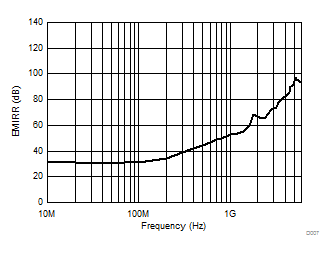SBOSAH8B February 2024 – May 2024 TLV9051-Q1 , TLV9052-Q1
PRODMIX
- 1
- 1 Features
- 2 Applications
- 3 Description
- 4 Pin Configuration and Functions
-
5 Specifications
- 5.1 Absolute Maximum Ratings
- 5.2 ESD Ratings
- 5.3 Recommended Operating Conditions
- 5.4 Thermal Information for Single Channel
- 5.5 Thermal Information for Dual Channel
- 5.6 Thermal Information for Quad Channel
- 5.7 Electrical Characteristics: VS (Total Supply Voltage) = (V+) – (V–) = 1.8V to 5.5V
- 5.8 Typical Characteristics
- 6 Detailed Description
- 7 Application and Implementation
- 8 Device and Documentation Support
- 9 Revision History
- 10Mechanical, Packaging, and Orderable Information
Package Options
Refer to the PDF data sheet for device specific package drawings
Mechanical Data (Package|Pins)
- PW|8
Thermal pad, mechanical data (Package|Pins)
Orderable Information
6.3.4 EMI Rejection
The TLV905x-Q1 uses integrated electromagnetic interference (EMI) filtering to reduce the effects of EMI from sources such as wireless communications and densely-populated boards with a mix of analog signal chain and digital components. EMI immunity can be improved with circuit design techniques; the TLV905x-Q1 benefits from these design improvements. Texas Instruments has developed the ability to accurately measure and quantify the immunity of an operational amplifier over a broad frequency spectrum extending from 10MHz to 6GHz. Figure 6-1 shows the results of this testing on the TLV905x-Q1. Table 6-1 lists the EMIRR IN+ values for the TLV905x-Q1 at particular frequencies commonly encountered in real-world applications. The EMI Rejection Ratio of Operational Amplifiers application note contains detailed information on the topic of EMIRR performance as it relates to operational amplifiers.
 Figure 6-1 EMIRR Testing
Figure 6-1 EMIRR Testing| FREQUENCY | APPLICATION OR ALLOCATION | EMIRR IN+ |
|---|---|---|
| 400MHz | Mobile radio, mobile satellite, space operation, weather, radar, ultra-high frequency (UHF) applications | 41.8dB |
| 900MHz | Global system for mobile communications (GSM) applications, radio communication, navigation, GPS (to 1.6GHz), GSM, aeronautical mobile, UHF applications | 53.1dB |
| 1.8GHz | GSM applications, mobile personal communications, broadband, satellite, L-band (1GHz to 2GHz) | 71.8dB |
| 2.4GHz | 802.11b, 802.11g, 802.11n, Bluetooth®, mobile personal communications, industrial, scientific and medical (ISM) radio band, amateur radio and satellite, S-band (2GHz to 4GHz) | 70.0dB |
| 3.6GHz | Radiolocation, aero communication and navigation, satellite, mobile, S-band | 81.2dB |
| 5GHz | 802.11a, 802.11n, aero communication and navigation, mobile communication, space and satellite operation, C-band (4GHz to 8GHz) | 92.5dB |